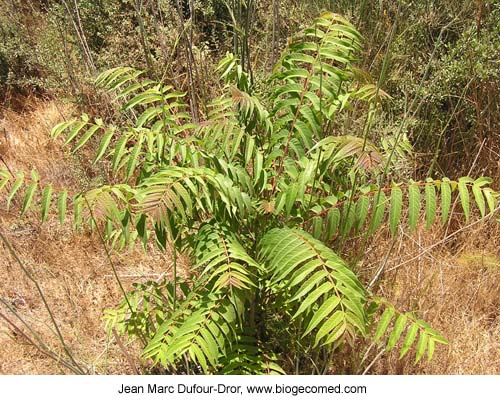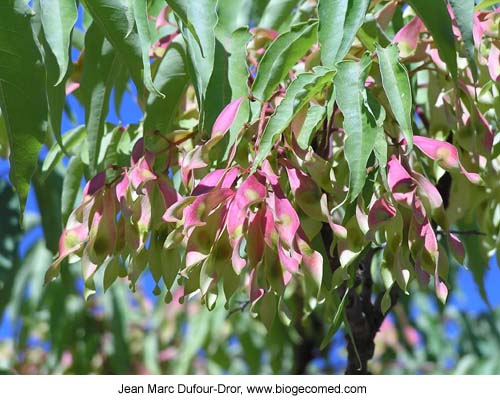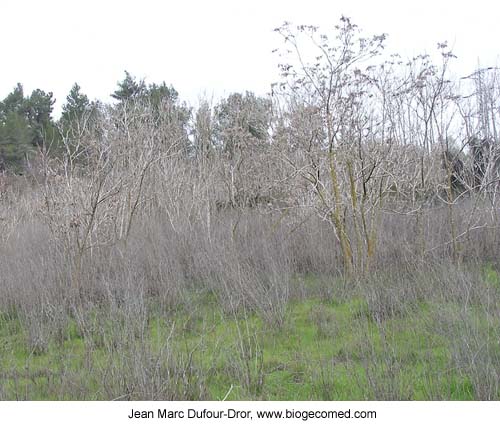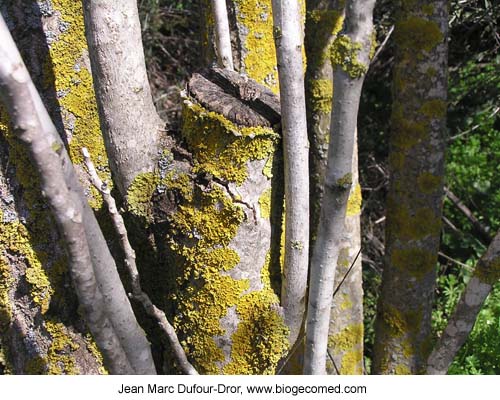|
General
Ailanthus altissima (Mill.) Swingle
Simaroubaceae
Life form: Deciduous tree
En: Tree-of-heaven, Chinese sumac, Fr: Ailante glanduleux, Faux-vernis
du Japon
Provenance: Southeast China, Taiwan

Distribution in Israel
The tree-of-heaven is a widespread alien species in the Mediterranean
region of Israel which occurs generally in low densities and
mainly along roadsides. Exceptions are in the Judean mountains
region, west to Jerusalem, and in the eastern Galilee, where
it forms large populations in protected sites and in open areas.
The nature reserve of 'Nahal Halilim', west of Jerusalem, is
probably one of the protected sites which is most infested with
the tree-of-heaven. In this reserve Ailanthus altissima
forms tall and dense thickets where a single native plant species
cannot be found.

Proliferation status
Ailanthus altissima in Israel is considered an invasive
species, according to terminology suggested by Richardson et
al. (2000).
Ailanthus altissima in Israel
The tree-of-heaven was introduced in Israel presumably during
the 1920s during the British mandate period. The tree was intensively
used in urban gardening during the 1970s in the capital city,
as it grows extremely rapidly. It was decided to stop planting
Ailanthus altissima in the late 1980s because it had started
to proliferate within the urban area causing damage to sidewalks,
streets, and other built-up structures.
The cities where Ailanthus altissima has been planted
today constitute the major proliferation source toward surrounding
open and protected areas. Unlike some other invasive alien plants
the tree-of-heaven does not occur only on road sides, but can
develop and form large populations also in undisturbed sites
such as nature reserves.
The tree-of-heaven poses a serious threat to natural areas in
Israel, particularly in the Judean Hills region. Yet, it is still
possible to stop its proliferation provided immediate measures
are undertaken: (1) Eradication of the planted tree individuals
in urban areas, (2) control of the trees that have developed
in protected areas, (3) follow-up. A lack of control program
will inevitably result in a large scale proliferation comparable
to that of Acacia saligna.


Control
Physical control is effective only when roots can be removed.
The plant resprouts vigorously and therefore felling the trees
is not effective and may even be counter-productive. Chemical
treatments have proved relatively effective: Glyphosate can be
spayed directly on foliage or injected into the trunk; picloram
can be used for treating cut stumps.
A research study currently in progress near Jerusalem has shown
that the injection of undiluted glyphosate with the drill-fill
method has led to a cessation of photosynthetic activity for
78% of the trees treated, while 100% of the targeted individuals
did not produce seeds. Yet, follow-up and monitoring are necessary
in order to assess for the effectiveness of the treatment through
time.

References
Knapp L.B. & Canham C.D. (2000) Invasion of an old-growth
forest in New-York by Ailanthus altissima; sapling growth
and recruitment in canopy gaps. Journal of the Torrey Botanical
Society 127:307-315.
Lawrence J.G., Colwell A. &
Sexton O.J. (1991) The ecological impact of a allelopathy in
Ailanthus altissima (Simaroubaceae). American Journal
of Botany 78(7):948-958.
Pannill P. (1995) Tree-of-Heaven
Control. Maryland Department of Natural Resources Forest Service
Stewardship Bulletin. 8 pp. |
